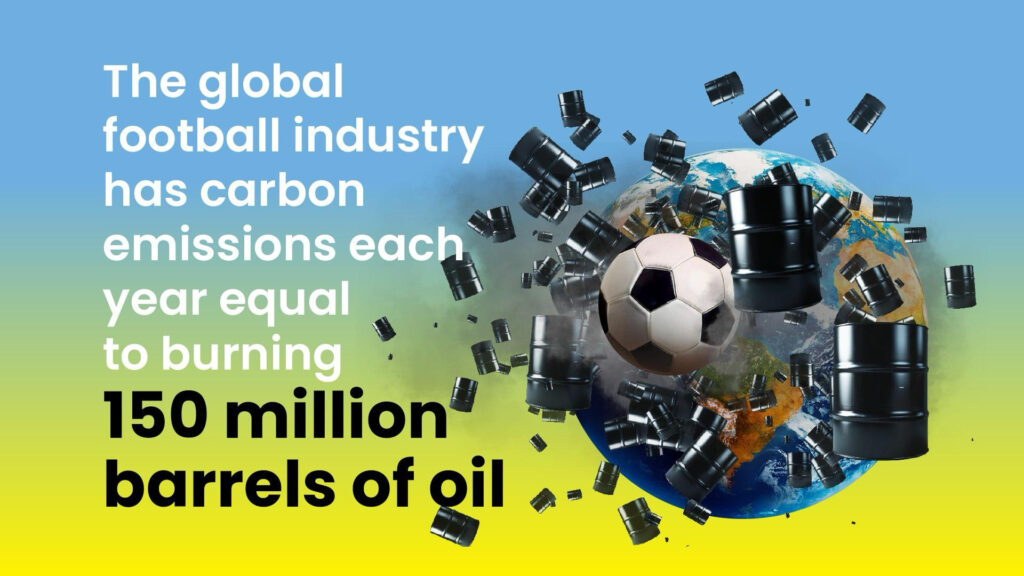A New Weather Institute report Dirty Tackle – the growing carbon footprint of football released today reveals that the carbon footprint of the global football industry is around the annual emissions of Austria or around 60% more than those of Uruguay, the nation that hosted the first World Cup in 1930. It is also equal to the emissions from burning 150 million barrels of oil.
The research is the first industry-wide global assessment of football’s carbon emissions, using a recently developed methodology from the New Weather Institute. It covers stadium-level emissions, including those due to construction, all travel-related emissions, merchandise, and the environmental impact of key sponsorship deals with polluting companies. It also assesses international and club competitions across the mens’ and women’s games. This more robust assessment of football’s impact is the first of its kind, and aims to help football better address its growing contribution to climate change.

David Wheeler, professional football player for Wycombe Wanderers FC, said:
“The climate crisis is quickly becoming a huge concern for professional players as it is threatening the future of football. As a player and a parent, I want kids to have the same opportunities to play the game that I had growing up. The climate crisis is threatening that.
Addressing football’s growing environmental impact, and cutting its emissions, is essential for securing a future where football can continue to excite and inspire new generations. There are green shoots that are starting to spring up on football pitches around the world, where fans and players are coming together to demand ambitious and immediate action. What is needed, though, is real leadership from governing bodies. They are already under pressure from players when it comes to the ever expanding football calendar, which is overburdening players. As players, we are not afraid to use our voices – but we need FIFA and those at the top to listen.”
Before this report, previous estimates of football’s environmental impacts have been low quality. These estimates have excluded key elements of the sport’s emissions, leading to a widespread underestimation of football’s impact and piecemeal attempts to address them. Climate action within football remains in its infancy, generally focusing on reducing operational emissions. But these efforts are undermined by the major expansion of international tournaments, the number of matches played, and promotion of polluting corporations. This report explains how meaningful reductions mean tackling all of these issues, as well as taking responsibility for the transport of those attending matches.
According to the new data, just one match at a FIFA Men’s World Cup Finals is estimated to emit between 44,000tCO2e and 72,000tCO2e; the equivalent to between 31,500 and 51,500 average UK cars driven for an entire year. These figures don’t include high carbon sponsorship-related emissions, which are estimated, on average, to increase total emissions by over 350% per fixture. In the English Premier League, one fixture is estimated to emit approximately 1,700 tCO2e, with travel-related emissions comprising around half of the total. This goes up by about 50% for a match in an international club competition, mainly due to air travel by spectators, and even more once sponsored emissions are included.
Tessel Middag, professional football player for Rangers F.C with 44 caps for the Dutch national team, said:
“Football needs to wake up to the threat posed to it by climate change. From each flooded pitch to players endangered by extreme heat, climate impacts are beginning to erode the foundations of football. Without urgent change, it is only going to get worse. Instead of being a source of pollution, football can be a powerful tool for change, using a sport that is so loved and adored around the world to secure a healthy, habitable planet.”

Key findings in the report include:
- The primary sources of football’s pollution are: sponsorship deals with heavily polluting companies, travel for matches (both international and domestic), and stadium construction. Overall, total emissions are approximately 64-66 million tCO2e per year.
- Sponsorships that promote heavily polluting activities are by far the largest contributor to football’s carbon footprint, making up 75% of the total. These ‘sponsored emissions’ increase the demand for polluting products and lifestyles, such as long-distance air travel, among the game’s global audience of billions.
- Excluding the emissions derived from sponsorship, the global total carbon footprint of football’s activities is estimated to be 13-15 million tCO2e per year, equivalent to the emissions of a nation such as Costa Rica.
- The activities which contribute most to this total are fan travel to matches and the construction of new stadiums. Air transport and car transport are particularly problematic.
- There is clear evidence that the expansion of international football tournaments, and the increase in air travel they drive, are increasing emissions.
- The FIFA men’s World Cup has in recent years been responsible for 6.5 million tCO2e over its four-year cycle, which includes both the qualification and the finals. Most of the emissions are concentrated during the finals. This total does not include sponsored emissions which vary considerably from tournament to tournament.
- Total emissions from women’s football represent a very small fraction of those of the men’s game, but are likely to rise quickly due to the current expansion of the sport.
Professional footballers and campaigners are using this new data to demand greater climate action from football’s governing bodies and decision-makers – including ending polluting sponsorship deals and the expansion of international tournaments – warning that football is increasingly vulnerable to the impacts of climate change. Most recently, wildfire-burned Los Angeles it set to host eight matches at the 2026 World Cup, sponsored by the world’s largest oil and gas company, Aramco.

Unfortunately, there has been very little acknowledgement from football’s governing bodies over the threat posed to the entire football pyramid from climate change and the game’s responsibility to act. Most notably, FIFA entered a huge, unprecedented commercial partnership with Aramco, the state-owned fossil fuel giant of Saudi Arabia and the world’s largest oil and gas corporation. The sponsorship deal was criticised by more than 130 female players due to concerns for women’s rights, the safety of LGBTQ+ communities, and Aramco’s continued pollution.
While both FIFA and UEFA have signed up to the UN Sports for Climate Action Framework, which commits them to a 50% reduction of emissions by 2030, expanding tournaments and polluting sponsorship indicate that emissions are not going down, let alone to the extent necessary to fulfill those public commitments.
Dr. Stuart Parkinson, from Scientists for Global Responsibility who led the research, said:
“Despite its mass appeal and global audience, football is struggling to get a handle on its true environmental impact due to patchy data and the exclusion of key areas of its carbon footprint, especially sponsored emissions. This research documents compelling evidence that football is a major polluter and its contribution to climate change is growing. It also shows that there is little indication that decision-makers are prepared to adequately assess the game’s pollution problem, let alone take the steps necessary to reduce it.”
Read the full report here: Dirty Tackle – the growing carbon footprint of football














